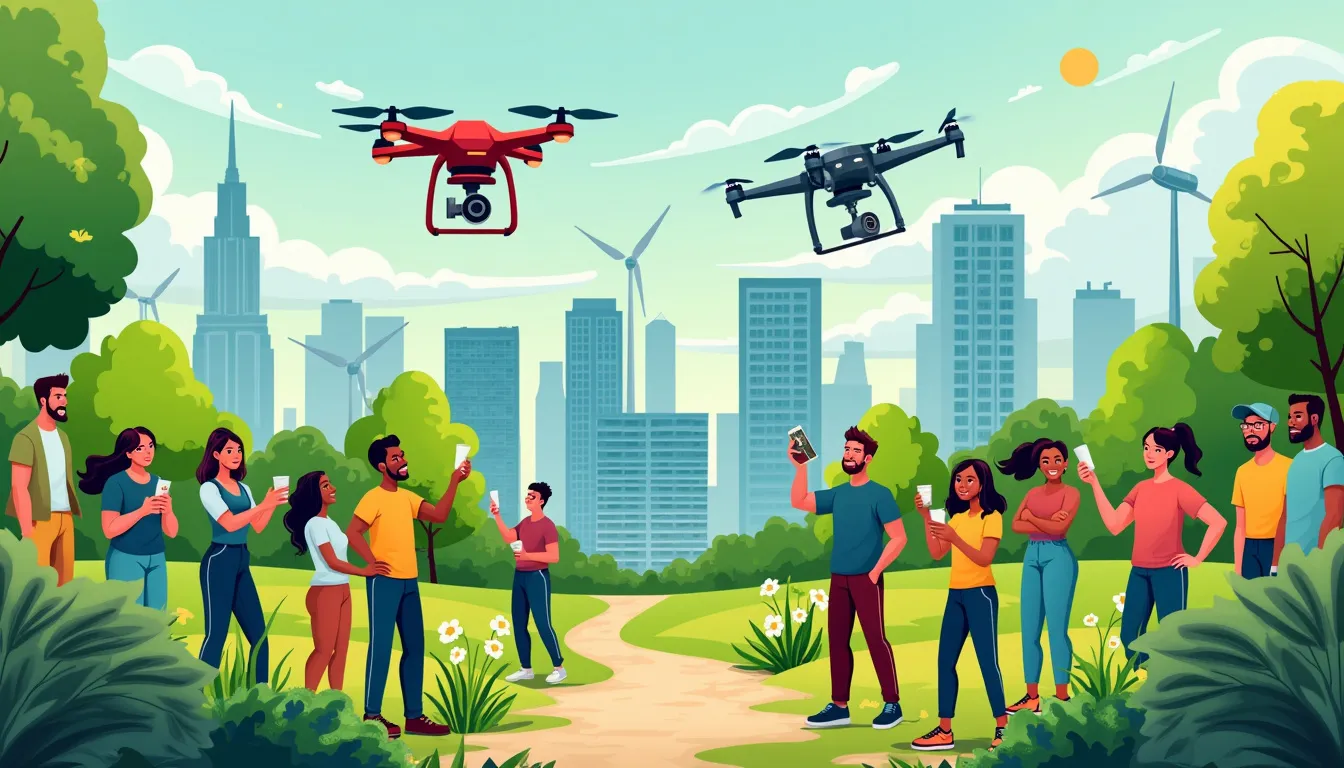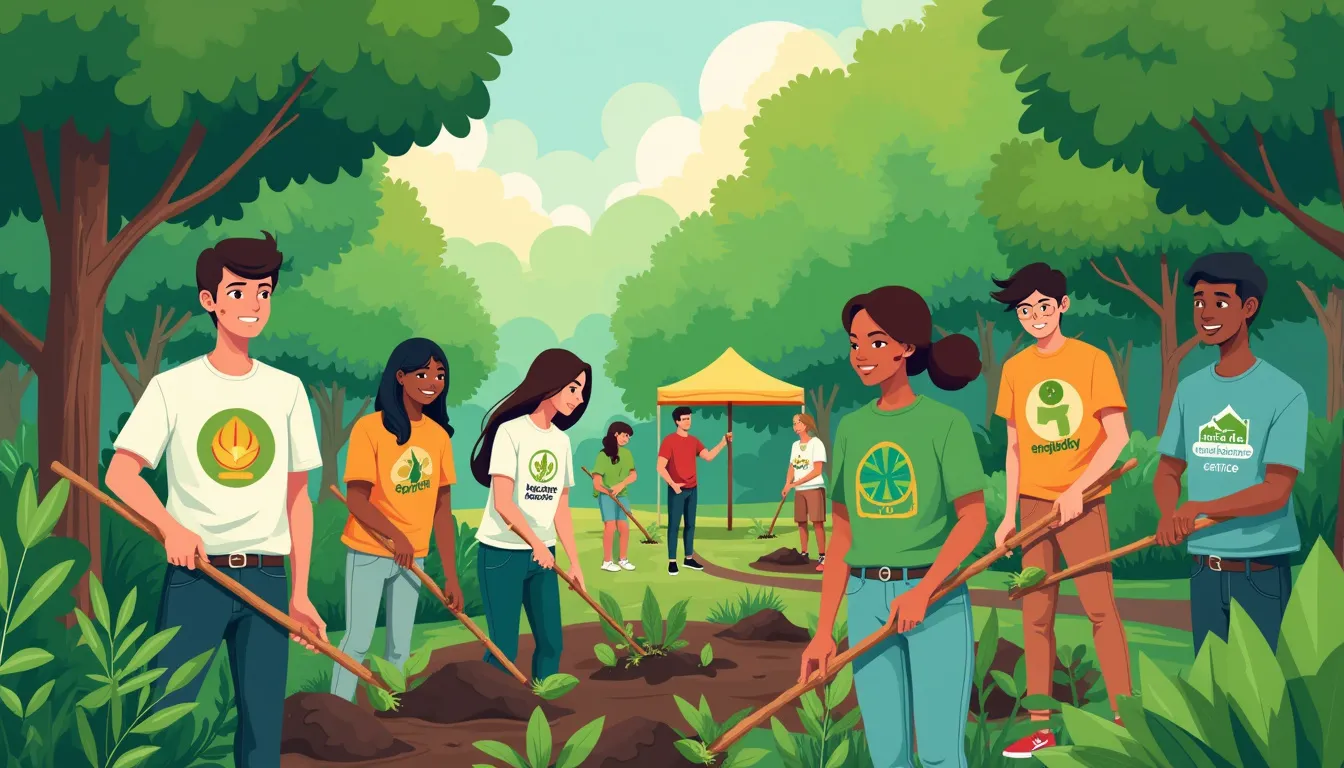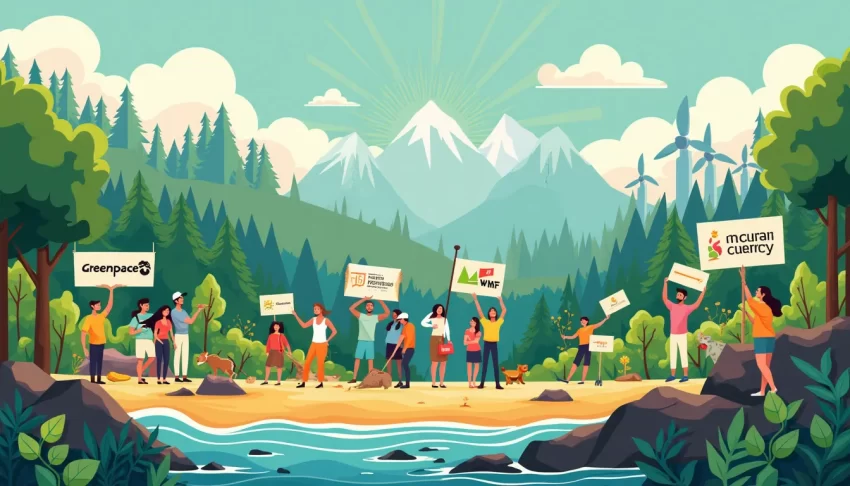In today’s rapidly changing world, environmental organizations play a pivotal role in addressing the pressing issues that threaten our planet. From combating climate change to protecting endangered species, these organizations have become the champions of sustainable development and ecological preservation. Their importance cannot be overstated, as they work tirelessly to implement policies, educate the public, and inspire global action towards a healthier, more sustainable future. The collective impact of these organizations is immense; they lobby for environmental regulations, spearhead conservation projects, and drive initiatives that mitigate environmental degradation on a global scale.
Understanding the effectiveness of environmental organizations can sometimes feel daunting, but a few key metrics can help us gauge their impact. These include the scope and reach of their initiatives, the success rates of their campaigns, the tangible outcomes of their projects, and their ability to mobilize resources and communities. By evaluating these factors, we can appreciate the vital contributions of these organizations and recognize the importance of supporting their efforts.
In this article, we will delve into the world of environmental organizations, profiling some of the leading global entities such as Greenpeace, WWF, and the Sierra Club. We will explore their primary initiatives and groundbreaking campaigns, analyzing their significant achievements in safeguarding our environment. Additionally, we will turn our focus to emerging organizations that are making a notable impact with innovative approaches and fresh perspectives. Through case studies and real-world examples, we will highlight how these newer entities are contributing to the global environmental movement.
Finally, we will provide actionable insights on how individuals and businesses can support these vital organizations. From volunteering opportunities to donation channels, and the importance of advocacy and awareness campaigns, we will equip you with practical ways to make a difference. By the end of this journey, we hope to inspire you to take part in the collective effort to protect our planet and ensure a sustainable legacy for future generations.
Introduction to Environmental Organizations
In a world increasingly aware of the importance of preserving our natural surroundings, environmental organizations play a pivotal role. The significance of these organizations cannot be overstated; they are on the frontline, tackling some of the most pressing environmental issues of our time.
The Importance of Environmental Organizations in Today’s World
Environmental organizations are crucial because they mobilize resources, raise awareness, and create actionable plans to combat environmental degradation. They serve as watchdogs that hold corporations and governments accountable, ensuring that the exploitation of natural resources is kept in check. Additionally, these groups often spearhead groundbreaking research and drive innovations that aim to create a sustainable future for all.
Overview of the Impact These Organizations Have on Global Environmental Issues
The impact of environmental organizations can be observed globally through various initiatives and campaigns. For instance, organizations like Greenpeace have waged successful campaigns to reduce whaling and promote renewable energy. Similarly, the World Wildlife Fund (WWF) has been deeply involved in wildlife conservation and the protection of endangered species. Furthermore, the work of these organizations often leads to significant policy changes and the implementation of international agreements like the Paris Agreement, aimed at reducing carbon emissions.
Introduction to Key Metrics for Evaluating the Effectiveness of Environmental Organizations
Evaluating the effectiveness of environmental organizations involves looking at several key metrics. These include:
- Impact Measurements: The tangible positive outcomes resulting from their initiatives, such as reduced carbon emissions, increased biodiversity, and improved ecosystems.
- Financial Transparency: How well these organizations allocate their funding towards their missions and how transparent they are about their finances.
- Stakeholder Engagement: The extent to which these organizations involve and collaborate with local communities, governments, and other stakeholders.
- Long-term Sustainability: The durability and lasting impact of their projects and programs.
Understanding these metrics can help individuals and businesses make informed decisions about which environmental organizations to support. For example, Charity Navigator and GuideStar are excellent resources that provide ratings and reviews of nonprofit organizations, including environmental groups, based on these key metrics.
In essence, environmental organizations have become indispensable allies in the fight against climate change, habitat destruction, and pollution. As we continue to confront these global challenges, the knowledge, resources, and activism provided by these organizations are more vital than ever.

Leading Global Environmental Organizations
When discussing the champions of our planet, certain names inevitably rise to the forefront. These leading global environmental organizations have carved a niche for themselves through relentless advocacy, groundbreaking initiatives, and unparalleled dedication to the health of our planet. Let’s delve into the profiles of some of the most influential organizations and examine their primary initiatives and landmark achievements.
Greenpeace
Greenpeace has been a formidable force in the environmental movement since its establishment in 1971. Known for its direct-action approach, Greenpeace often takes dramatic steps to draw attention to critical environmental issues. From scaling oil rigs to obstructing whaling ships, their boldness has made headlines and spurred global conversations.
Primary Initiatives
Greenpeace focuses on several core areas:
- Climate Change: Pushing for renewable energy use and policy changes to reduce carbon emissions.
- Deforestation: Fighting to protect ancient forests and push for zero deforestation policies.
- Oceans: Combating overfishing, plastic pollution, and protecting marine ecosystems.
- Toxic Chemicals: Addressing the use of hazardous chemicals in industries and their environmental and health impacts.
Successful Campaigns
One notable Greenpeace campaign is their relentless fight against deforestation in the Amazon. By exposing the link between large-scale soy plantations and deforestation, Greenpeace influenced major corporations to commit to zero-deforestation supply chains. Another significant victory was their campaign to save the Arctic from oil drilling, resulting in Shell abandoning its drilling plans in the region in 2015.
World Wildlife Fund (WWF)
The World Wildlife Fund (WWF), founded in 1961, is one of the world’s most prominent conservation organizations. With a panda as its iconic symbol, WWF works on a variety of fronts, including species protection, habitat conservation, and the sustainability of natural resources.
Primary Initiatives
WWF’s work is comprehensive and global, including:
- Species Conservation: Protecting endangered species such as tigers, pandas, and elephants through habitat preservation and anti-poaching activities.
- Forest Conservation: Promoting sustainable forestry practices and protecting critical forest landscapes.
- Climate and Energy: Advocating for clean energy solutions and policies to mitigate climate change.
- Food: Promoting sustainable agricultural practices to ensure food security and conservation.
Successful Campaigns
WWF has been pivotal in numerous successful conservation efforts. Their campaign for the protection of the Amur tigers in Russia is an exemplar, where their efforts led to a significant increase in the tiger population. Additionally, their cooperation with governments and corporations has resulted in the expansion of marine protected areas, safeguarding vital ocean habitats.
Sierra Club
Founded in 1892 by conservationist John Muir, the Sierra Club is one of the oldest and most respected grassroots environmental organizations in the United States. The club’s vast network of volunteers and activists makes it particularly effective in championing environmental causes locally and nationally.
Primary Initiatives
The Sierra Club’s initiatives are multifaceted, including:
- Clean Energy: Advocating for a transition from fossil fuels to renewable energy sources.
- Land and Water Protection: Preserving wildspaces through national, state, and local advocacy.
- Climate Action: Mobilizing communities to combat climate change through policy and grassroots action.
- Environmental Justice: Addressing the disproportionate environmental burdens faced by marginalized communities.
Successful Campaigns
The Beyond Coal campaign is one of the Sierra Club’s standout successes. Launched in 2010, the campaign’s aim was to retire one-third of the nation’s coal plants by 2020. By 2019, the closure of over 290 coal plants had been achieved, significantly reducing carbon emissions and demonstrating the power of a well-organized grassroots movement. Additionally, the Sierra Club has been instrumental in the establishment and maintenance of protected areas, such as national parks and wilderness areas across the United States.
Analysis of Contributions to Major Environmental Milestones
Each of these organizations has played a crucial role in driving key environmental milestones. For instance:
- International Climate Agreements: Groups like Greenpeace and WWF have been vocal participants in climate summits, influencing international agreements such as the Paris Agreement.
- Conservation Achievements: WWF has been critical in the establishment of new protected areas and the development of conservation policies that benefit both wildlife and human communities.
- Local and National Environmental Policies: The Sierra Club’s advocacy has shaped policies that support renewable energy, protect natural habitats, and promote sustainable development at various governmental levels.
By leveraging their unique strengths and areas of expertise, these organizations have made indelible marks on the global environmental landscape. Their successes provide a blueprint for emerging organizations and underscore the vital role that informed, persistent advocacy plays in achieving environmental sustainability.
Understanding the contributions of these leading environmental organizations highlights just how significant their impact has been on our world. Whether guilelessly navigating political avenues or fearlessly challenging corporate behemoths, the efforts of Greenpeace, WWF, and the Sierra Club demonstrate the profound difference that organized environmental advocacy can make.

Innovative Approaches by Emerging Environmental Organizations
While established environmental organizations have been crucial in pushing forward the green agenda, many newer groups are bringing fresh, innovative perspectives to the table. Harnessing technology, leveraging local knowledge, and fostering community engagement, these emerging organizations are not only making waves but also setting new benchmarks in environmental advocacy and action.
Spotlight on Newer Environmental Organizations Making a Mark
Let’s dive into the world of some trailblazing emerging environmental organizations that are driving significant change:
1. The Ocean Cleanup:
Founded in 2013 by then-18-year-old Boyan Slat, The Ocean Cleanup has made headlines with its ambitious goal: to rid the oceans of plastic. What sets this organization apart is its focus on technological innovation. They have developed advanced systems to capture plastic debris in oceans and rivers, preventing it from reaching vulnerable ecosystems.
An exemplary project is the deployment of their Interceptor solutions in rivers that are major sources of ocean plastic pollution. By targeting over a thousand rivers, The Ocean Cleanup aims to intercept the flow of plastic waste before it reaches the oceans, combining cutting-edge engineering with strategic deployment.
Unique Strategies and Innovative Solutions
Emerging environmental organizations often stand out due to their novel approaches. Here’s how some of them are leveraging ingenuity to tackle environmental challenges:
1. Biomimicry Institute:
The Biomimicry Institute promotes a design methodology that mimics nature’s time-tested patterns and strategies to address human challenges sustainably. For instance, their Ray of Hope Prize awards groundbreaking startups that create sustainable solutions inspired by nature. One such innovation is Pheronym, which uses pheromones to control agricultural pests naturally, reducing the need for harmful chemical pesticides.
2. Ecosia:
Imagine fighting deforestation with every internet search you perform. That’s exactly what Ecosia, a search engine, is accomplishing. Powered by the idea that tree planting can change the world, Ecosia uses its ad revenue to plant trees where they’re most needed. To date, they have planted over 100 million trees across more than 35 countries. By combining daily internet use with tangible environmental action, they’ve engaged a broad audience in the cause of reforestation.
3. Plastic Bank:
Plastic Bank offers an innovative solution to marine plastic while simultaneously alleviating poverty. They encourage people in impoverished areas to collect plastic waste in exchange for money, goods, or digital tokens. This not only reduces plastic pollution but also provides economic opportunities for the participants. Their blockchain-secured platform ensures transparency and traceability, building trust and accountability in the process.
Case Studies of Notable Projects and Their Outcomes
The effectiveness of innovative approaches often shines through in the results. Here’s a closer look at some notable projects and their positive impacts:
Clean Energy Access in East Africa:
Organizations like Energy 4 Impact are revolutionizing access to clean energy in underdeveloped regions. Through their MicroGrid Initiative, they have facilitated the installation of solar mini-grids in remote East African communities, providing reliable electricity to areas previously off the power grid. This sustainable energy access is fostering economic development, improving healthcare, and enhancing educational opportunities for thousands of people.
Air Quality Monitoring in Urban Areas:
Air pollution is a pressing issue in many urban centers. OpenSense, a German-based organization, uses a network of citizen scientists to monitor air quality with low-cost sensors. This crowdsourced data is freely available to the public, empowering communities to advocate for cleaner air. In cities like Stuttgart, this initiative has led to urban planning changes that prioritize pedestrian zones and green spaces, directly contributing to better air quality.
Community-Led Conservation in the Amazon:
Amazon Conservation Team (ACT) collaborates directly with indigenous communities to protect the Amazon rainforest. One of their remarkable projects involved mapping uncharted territories of the Amazon basin with the help of indigenous tribes. This cultural and technological collaboration has secured thousands of acres of rainforest, safeguarding biodiversity and indigenous ways of life.
Be Inspired by Innovation and Action
The work of these emerging environmental organizations demonstrates that creative and inclusive approaches can lead to substantial and impactful change. From leveraging cutting-edge technology to engaging local communities directly, these groups remind us that sustainable solutions often come from thinking outside the box. As consumers, business owners, and global citizens, we can draw inspiration from their strategies and apply similar principles to our own sustainability efforts.

How to Support Environmental Organizations
Supporting environmental organizations is crucial in amplifying their impact and ensuring their initiatives continue to create meaningful change. Whether you are an individual with a passion for the environment or a business looking to incorporate sustainability into your corporate strategy, there are several practical ways to contribute. Here are various methods to support environmental organizations:
Volunteer Opportunities
One of the most impactful ways to support environmental organizations is through volunteering. Many organizations offer a range of volunteer opportunities that cater to different skills and availability. For instance, Greenpeace welcomes volunteers for campaigns, events, and even office tasks. Similarly, the World Wildlife Fund (WWF) has volunteer programs that focus on conservation projects, such as reforestation and wildlife monitoring.
Volunteering not only helps the organization but also offers personal satisfaction and an opportunity to learn more about environmental issues. Here are a few questions to consider when looking for volunteer opportunities:
- What skills can you offer? Consider your background and what you can bring to the table. Whether it’s graphic design, marketing, or simply a willingness to participate in local clean-ups, your skills can make a significant impact.
- How much time can you commit? Be realistic about your availability. Some organizations might require a regular commitment, while others might need help on a project-by-project basis.
- Are there local opportunities? Volunteering locally can be a great way to make a direct impact on your community. Many national organizations have local chapters or partner organizations you can work with.
Donation Channels
Financial support is vital for the sustainability of environmental organizations. Donations can be made in a variety of forms, including one-time gifts, monthly contributions, or even legacy gifts. Here’s how you can navigate the donation process:
First, research and choose an organization that aligns with your values. Websites like Charity Navigator and GuideStar provide detailed ratings and reviews of various non-profits, helping you make an informed decision.
Many organizations also offer the option to donate via different platforms. For example:
- World Wildlife Fund: Allows for customizable donation amounts and options for honoring someone with your donation.
- Sierra Club: Provides various giving options, from monthly donations to planned giving and stock transfers.
- Greenpeace USA: Offers the ability to donate quickly online or through gifts that can be made in cryptocurrencies.
Businesses can also contribute through corporate social responsibility (CSR) programs. Partnering with environmental organizations for sponsorship or employee volunteer programs can enhance corporate image and drive positive environmental change.
Advocacy and Spreading Awareness
Advocacy is another powerful tool to support environmental organizations. By raising awareness and influencing policy changes, you directly contribute to the broader mission of environmental preservation. Here’s how you can get started:
- Educate Yourself and Others: Understanding the critical issues and sharing that knowledge is a foundational step. Follow reputable news sources, attend webinars and read literature on environmental topics.
- Use Your Voice: Social media platforms are incredible tools for advocacy. Follow environmental organizations, share their posts, and use hashtags to increase visibility for their causes. Don’t underestimate the power of a well-timed tweet or Instagram story!
- Engage in Policy Change: Contacting your local representatives and participating in public comment periods for environmental legislation can drive significant policy shifts. Organizations like the Sierra Club often provide resources to help you get involved.
Another effective way to spread awareness is by hosting events or workshops to educate your community about environmental issues. Partner with local businesses or community centers to expand your reach.
Corporate Partnerships and Sponsorships
Businesses have a unique opportunity to support environmental organizations through strategic partnerships and sponsorships. By aligning with environmental causes, companies can enhance their brand reputation and demonstrate their commitment to sustainability. Here are some ways businesses can get involved:
- Event Sponsorship: Many environmental organizations host fundraising events, conferences, and awareness campaigns. Sponsoring these events not only provides financial support but also increases your business’s visibility and credibility.
- Corporate Volunteering Programs: Encouraging employees to volunteer for environmental causes can foster team building and morale while making a positive impact. Organizations like the VolunteerMatch allow businesses to connect with local volunteer opportunities.
- Product Partnerships: Consider developing eco-friendly products or services in collaboration with an environmental organization. These partnerships can lead to co-branded products that highlight sustainability efforts, benefiting both the business and the organization.
By actively participating in these initiatives, businesses can make a meaningful difference while also gaining loyal customers who value environmental responsibility.
Supporting environmental organizations—whether through volunteering, donating, advocating, or forming corporate partnerships—plays a crucial role in driving sustainable change. The cumulative effect of these efforts ensures that these organizations can continue to protect our planet for future generations.
In an era where climate change, deforestation, and pollution threaten the stability of our planet, environmental organizations stand as crucial pillars supporting the fight for a sustainable future. These dedicated groups, ranging from global giants like Greenpeace and WWF to emerging innovators, play a pivotal role in addressing the most pressing environmental challenges through impactful initiatives and campaigns. They not only raise awareness about these issues but also drive tangible changes that contribute to major environmental milestones, from conservation efforts to policy reforms.
Among the many champions of environmental stewardship, organizations like Greenpeace, WWF, and the Sierra Club have demonstrated outstanding leadership. Their efforts in areas such as wildlife protection, deforestation prevention, and climate advocacy have set strong precedents for environmental success. For instance, WWF’s work to safeguard endangered species has led to significant population recoveries, while the Sierra Club’s grassroots campaigns have brought about essential legislative changes protecting natural resources.
Meanwhile, new and emerging environmental organizations are bringing fresh perspectives and innovative solutions to the table. These groups often leverage cutting-edge technology and creative approaches to address environmental problems in ways that were previously unimaginable. From deploying AI to monitor deforestation to pioneering zero-waste community models, these organizations are carving out new paths in the landscape of environmental activism. Their unique projects and groundbreaking methods offer hope and inspiration, proving that ingenuity coupled with passion can indeed drive substantial change.
Supporting these organizations, whether well-established or newly-formed, is integral for anyone committed to a healthier planet. There are countless ways to contribute, tailored to fit diverse lifestyles and capabilities. Individuals and businesses alike can engage through volunteer opportunities, financial donations, and by advocating for environmental causes among their networks. Simple steps, like participating in local clean-ups, donating to reforestation projects, or even just spreading awareness on social media, can collectively lead to meaningful impacts.
It’s essential not to underestimate the power of community and collective effort. Each action, no matter how small, aligns us closer to a future where environmental sustainability is not just an aspiration but a lived reality. By championing the cause of these environmental organizations, supporting their initiatives, and perhaps even leading by example in our daily lives and businesses, we contribute to a legacy of preservation and stewardship for generations to come. It’s a shared responsibility that beckons us all to participate, making our earth a better place through mindful and concerted efforts.
So, whether you’re inspired to volunteer, donate, or simply spread the word, know that every bit helps. Let’s become active stewards of our planet, ensuring that the impact of these incredible environmental organizations is amplified and sustained, fostering a healthier, safer world for all.
Support Us: Check out our recommended products on Amazon.

